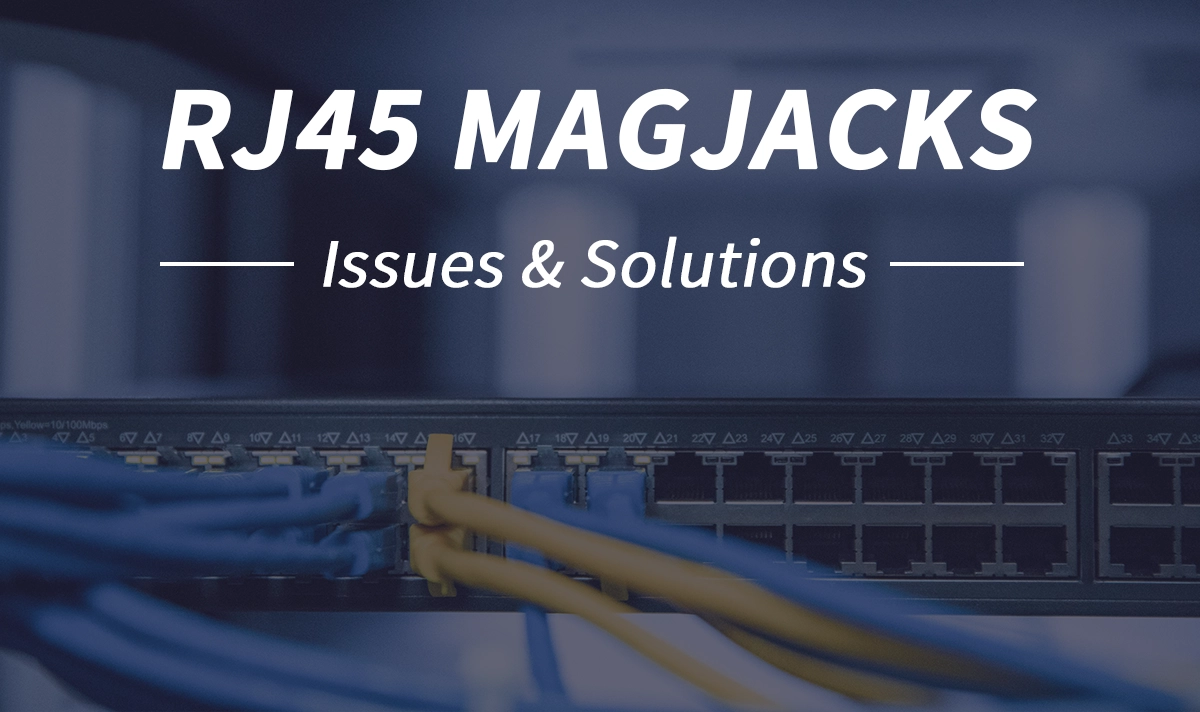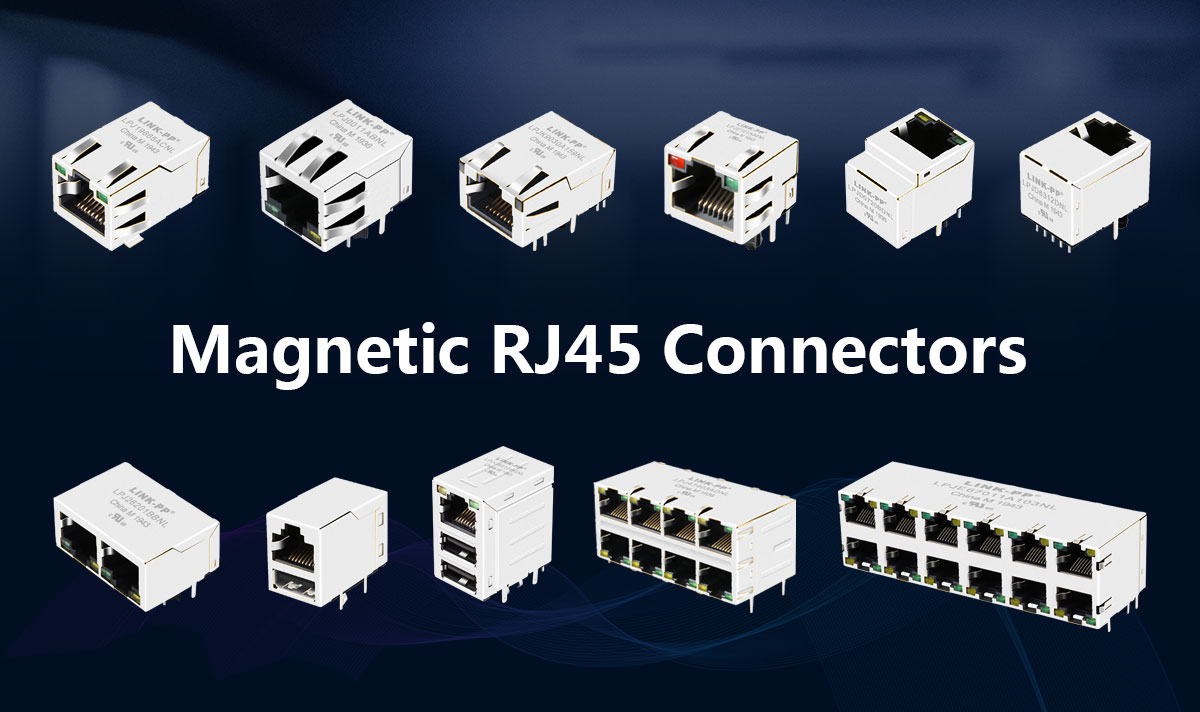
Is your network dropping out? Experiencing slow speeds or dead ports? The humble RJ45 Magjack (Magnetics Module + Jack) is often the unsung hero – or culprit – in your Ethernet connection. This comprehensive guide dives deep into the 10 most common RJ45 Magjack failures, their root causes, and actionable solutions. Learn how to diagnose issues, implement effective fixes, and choose reliable components like LINK-PP Magjacks to ensure robust, uninterrupted network performance. Whether you're a network engineer, hardware designer, or IT professional, master the art of Magjack maintenance and troubleshooting!
1. Introduction: The Critical Role of the RJ45 Magjack
RJ45 Magjacks integrate signal transformers (magnetics), common-mode chokes, and the physical connector into one module. They provide electrical isolation, noise suppression, signal integrity, and physical interface stability. Failure can cripple network ports, causing costly downtime. Understanding RJ45 connector issues, Ethernet port failure, and Magjack troubleshooting is essential for robust infrastructure.
2. Common RJ45 Magjack Failures & Their Root Causes
🔥 2.1. Physical Damage & Wear (The Obvious Culprit)
Symptoms: Bent/broken pins, cracked housing, loose port, intermittent connection.
Causes: Rough mating/unmating, excessive cable strain, mechanical shock, poor-quality jacks.
Keywords: RJ45 jack damaged, broken Ethernet port, RJ45 connector repair.
⚡ 2.2. Electrical Overstress (EOS) & Electrostatic Discharge (ESD)
Symptoms: Complete port failure, erratic behavior, link instability.
Causes: Power surges, improper grounding, poor ESD handling during installation.
Keywords: Ethernet port ESD damage, RJ45 surge protection, Magjack EOS failure.
🌡️ 2.3. Thermal Stress & Overheating (Especially in PoE)
Symptoms: Port dropping under load, discolored plastic, burning smell, reduced lifespan.
Causes: Inadequate heatsinking, high ambient temps, exceeding PoE power limits, poor airflow.
Keywords: PoE Magjack overheating, RJ45 thermal management, Ethernet port hot.
📡 2.4. Signal Integrity Degradation & EMI/RFI Issues
Symptoms: High packet loss, reduced speed, increased latency, link negotiation failures.
Causes: Compromised magnetics, poor PCB layout, lack of shielding, ground loops, external noise sources.
Keywords: Ethernet signal noise, RJ45 EMI problems, Magjack signal integrity.
🧪 2.5. Corrosion & Contamination
Symptoms: Intermittent connection, high resistance, visible green/white residue on pins.
Causes: Exposure to humidity, sulfurous environments (H2S), salt spray, dust ingress, flux residue.
Keywords: RJ45 corrosion, Ethernet port contamination, Magjack environmental failure.
🔌 2.6. PoE (Power over Ethernet) Related Failures
Symptoms: PD (Powered Device) not powering up, unstable power delivery, port shutdown.
Causes: Overcurrent, short circuits, incompatible Power over Ethernet (PoE) standards (802.3af/at/bt), faulty signature detection.
Keywords: PoE port failure, RJ45 Magjack PoE issue, Ethernet power delivery problem.
🧩 2.7. Magnetics Saturation or Failure
Symptoms: Distorted signals, inability to establish link at certain speeds/distances.
Causes: DC imbalance on transformer windings, excessive current, manufacturing defects.
Keywords: Ethernet transformer failure, Magjack magnetics issue, RJ45 signal distortion.
🛠️ 2.8. Solder Joint Fatigue & PCB Mounting Issues
Symptoms: Intermittent connectivity, port works only with pressure applied, visible cracked solder.
Causes: Mechanical stress/vibration, thermal cycling, poor soldering process.
Keywords: RJ45 solder joint failure, Ethernet port loose connection, PCB mount RJ45 issue.
⚖️ 2.9. Compatibility & Standards Mismatch
Symptoms: Link only at lower speeds (e.g., 10Mbps instead of 1Gbps), autonegotiation failures.
Causes: Using non-compliant cables (e.g., CCA), mismatched pairs, Magjack not rated for target speed/distance.
Keywords: RJ45 compatibility issues, Gigabit Ethernet problems, Cat6 connector failure.
🏭 2.10. Manufacturing Defects & Counterfeit Components
Symptoms: Premature failure, performance below spec, inconsistent behavior.
Causes: Substandard materials, poor quality control, fake components lacking proper magnetics/isolation.
Keywords: Fake RJ45 connectors, Magjack quality control, Ethernet component reliability.
3. Diagnosing RJ45 Magjack Problems: A Step-by-Step Guide
Visual Inspection: Check for physical damage, corrosion, contamination, overheating signs.
Cable & Device Swap: Rule out cable/device faults. Test with known-good components.
Link Status & LEDs: Observe port LED behavior (link, activity, speed).
Software Diagnostics: Use switch/router logs (
show interfaces), OS network diagnostics.Advanced Testing (If Possible):
Cable tester (checks continuity, opens, shorts, miswires).
TDR (Time Domain Reflectometer) for impedance mismatches/cable faults.
Protocol analyzer for packet errors, CRC errors.
Thermal imaging under load (for PoE issues).
> 🔍 Don't let network downtime cost you! Bookmark this guide for your next troubleshooting session. <<
4. Proven Solutions & Prevention Strategies
🛡️ 4.1. Combating Physical Damage & Wear
Solution: Replace damaged jacks. Use strain relief boots/cable clamps. Train staff on proper insertion/removal.
Prevention: Specify robust jacks with reinforced shrouds and high mating cycle ratings.
LINK-PP Recommendation: Consider LINK-PP LPJG0926HENL - Features a zinc alloy shield and enhanced durability for high-traffic environments.
⚡ 4.2. Mitigating EOS/ESD Damage
Solution: Replace damaged Magjack. Ensure proper chassis grounding. Use ESD-safe practices.
Prevention: Select Magjacks with high ESD protection ratings (e.g., ±15kV contact/air). Integrate TVS diodes on the line side.
LINK-PP Recommendation: LINK-PP LPJK9436AHNL offers excellent ESD protection (±16kV) and integrated common-mode chokes.
❄️ 4.3. Solving Thermal & PoE Overheating
Solution: Improve airflow, add heatsinks, reduce PoE load if possible, replace overheated Magjack.
Prevention: Choose Magjacks rated for target PoE class (esp. 802.3bt Type 4). Ensure adequate thermal design on PCB (thermal pads/vias, ground plane).
LINK-PP Recommendation: LINK-PP LPJQP96282-8AHNL is specifically designed for high-power PoE++ (Type 4) applications with superior thermal performance.
📶 4.4. Fixing Signal Integrity & EMI Issues
Solution: Use shielded cables (STP/FTP) properly grounded. Verify PCB layout (minimize trace lengths, solid ground plane, isolation gap). Add ferrites.
Prevention: Select Magjacks with high CMRR (Common-Mode Rejection Ratio) and appropriate shielding. Ensure magnetics are tuned for target speed/distance.
Keywords: Shielded RJ45 connector, EMI resistant Magjack, high CMRR transformer.
🧼 4.5. Addressing Corrosion & Contamination
Solution: Clean contacts carefully (isopropyl alcohol, contact cleaner). Replace severely corroded jacks.
Prevention: Specify Magjacks with corrosion-resistant contacts (e.g., thick gold plating over nickel). Use protective caps when unoccupied. Choose sealed/higher IP-rated jacks for harsh environments.
LINK-PP Recommendation: LINK-PP RJ45 Connectors support extended 50µ" gold plating for superior corrosion resistance.
5. RJ45 Magjack Solutions Comparison Table
Failure Mode | Immediate Fix | Long-Term Prevention Strategy | Key Component Specifications to Look For |
|---|---|---|---|
Physical Damage | Replace Magjack | Use strain relief; High-cycle rated jacks (e.g., >1500) | Reinforced housing (e.g., metal shield); Robust pin design |
EOS/ESD | Replace Magjack; Check Grounding | High ESD rated Magjack (±15kV+); TVS Diodes | ESD Protection Rating; Integrated Chokes |
PoE Overheating | Improve cooling; Reduce load; Replace | Magjack rated for target PoE Class; PCB thermal management | PoE Standard Compliance (af/at/bt); Thermal Pad Interface |
Signal Noise/EMI | Use shielded cables; Check layout | High CMRR (>40dB); Shielded Magjack; Proper PCB Layout | CMRR @ target freq; Shielding Type; Isolation Voltage |
Corrosion | Clean contacts; Replace if severe | Thick gold plating (≥ 30µ"); Sealed options; Protective caps | Contact Plating Thickness; IP Rating (e.g., IP40) |
Solder Joint Crack | Reflow solder; Replace Magjack | Proper footprint design; Adequate solder paste; Strain relief | Pad Design Compatibility; Robust SMT Terminals |
6. Choosing the Right RJ45 Magjack: LINK-PP Solutions

Selecting a high-quality, reliable Magjack is paramount for preventing failures. LINK-PP offers a comprehensive range engineered for performance and durability:
Standard Applications: LINK-PP LPJG16540AENL (100/1000Base-T, Cost-effective)
High-Power PoE++: LINK-PP LPJQP96282 (802.3bt Type 4 Compliant, Optimized Thermal)
Harsh Environments: LINK-PP LPJK0071AINL (Industrial Temperature -40℃~85℃)
10GBase-T: LINK-PP LPJM9661AGNL (10 Gigabit Performance, Low Skew)
> 🔌 Upgrade your network reliability! Explore the full range of industrial-grade LINK-PP RJ45 Magjacks designed to solve these common failures. Request a datasheet or samples today! <<
7. Installation Best Practices & Maintenance
Handling: Always use ESD precautions. Avoid touching pins.
Soldering: Follow recommended reflow profile strictly. Avoid tombstoning.
PCB Layout: Adhere strictly to manufacturer's footprint and layout guidelines (isolation gap, ground plane, keep-out zones). Critical for Gigabit Ethernet performance and signal integrity.
Cabling: Use certified cables (Cat5e, Cat6, Cat6a) matching the application speed. Ensure proper termination.
Preventive Checks: Periodically inspect ports for dust, damage, or overheating, especially in critical infrastructure.
8. Conclusion: Ensuring Long-Term RJ45 Magjack Reliability
RJ45 Magjacks are complex electromechanical components vital for network integrity. Understanding their common failure modes – from physical damage and ESD to PoE overheating and signal degradation – is the first step towards robust network design and maintenance. By implementing the diagnostic steps, solutions, and prevention strategies outlined here, and by choosing high-quality components like LINK-PP Magjacks engineered for specific challenges (be it harsh environments, high-speed data, or demanding PoE), you can significantly reduce downtime, improve network performance, and extend the lifespan of your hardware.




